Portugal is knocking
- Alentejo & Terras do Sado
Posted - December 3 2008
By Daenna Van Mulligen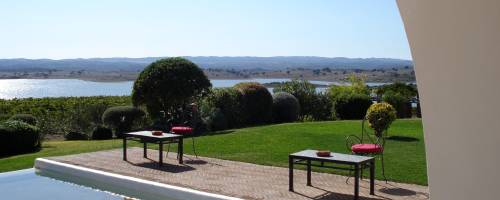
view from Herdade
Do Esporão
Terras do Sado – Southern
Region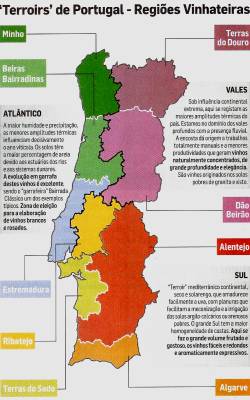
Terras do Sado is a small region
easily accessible by either of the two bridges over the river Tagus from Lisbon. It is known
primarily for its sweet Setúbal wines made from the Moscatel grape. However,
this small wine region is growing, which makes it hard to pinpoint all the
varietals being grown and planted, but traditionally it’s the red Castelão and
the white Moscatel. Only two DOCs – Setúbal and Palmela land inside the Vinho
Regional of Terras do Sado but it is home to one of the most famous Portuguese
producers, José Maria da Fonseca. Here, a soft, gooey sheeps milk cheese, famous
throughout Portugal, named Queijos de Azeitão after this area from where it
hails. It pairs well with the sweet or off-dry Moscatel wines or rosés.
Coutinho's map showing
Atlantic, Valley & South
Quinta de Catralvos
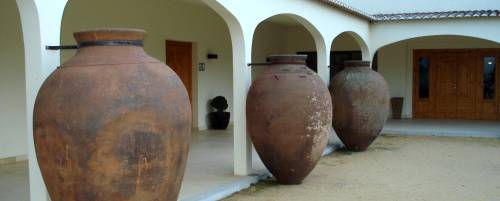
Quinta de Catralvos is a new, modern winery in Azeitão with a restaurant and conference facilities.
Because it has been so recently built, environmental technology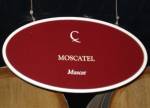 has be put in
place to allow for water recycling and a water treatment plant.
has be put in
place to allow for water recycling and a water treatment plant.
The Catralvos vineyards
are 20 hectares around the winery and 55 more near the Alentejo border in Pegóes
consisting of Fernão Pires, Moscatel, Arinto, Chardonnay, Periquita (aka
Castelão), Arogones (aka Tinta Roriz or aka Tempranillo in Spain), Touriga
Nacional, Syrah, Cabernet Sauvignon and Alicante Bouschet.
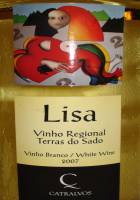
Fun wines – great labels with
consumer appeal
The Lisa Moscatel, Terras do Sado, 2007 has very appealing aromas of lychee,
tangerine peel, apricot, rose oil and spices. Its off-dry and very fresh on the
palate with zippy citric flavours and loads of spice. the texture is rounded and
almost oily. Very quaffable and great with spiced dishes.
Lisa Rosé Terras do Sado, 2007 is a blend of Touriga Nacional and Syrah with
aromas of sweet summer berries, cedar box, spices and candy floss. Its fun and
off-dry with peppery spiced berry flavours and a nice seam tannin and
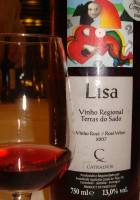 backbone
that makes it nice to pair with creamy, spiced dishes, fish and white meats.
backbone
that makes it nice to pair with creamy, spiced dishes, fish and white meats.
Lisa Red, Terras do Sado, 2007 blends Touriga Nacional with Castelão and Syrah
to make an easy drinking smoky red with berry fruit flavours and some
bittersweet chocolate and char undertones. The tannins are soft, the fruit
juicy, making an easy mid-week wine.
Amo-te Reserva Red, Terras do Sado, 2005 –Tthis is an interesting
product. The first time I saw the label I thought it was a bit precious – the
floral heart and the Portuguese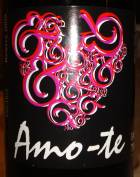 words amo-te (in love) seemed sweet but kind of
promotional. But I understand its appeals, especially to female consumers and of
course it’s perfect for weddings and Valentine’s Day. The wine inside isn’t
sweet and submissive by any means – it shows smoky dark berry and plummy aromas
with chocolate covered blueberries and espresso. It’s full bodied and spicy on
the palate smoothly textured with a dry finish. A blend of Cabernet Sauvignon,
Arogones, Syrah and Touriga Nacional.
words amo-te (in love) seemed sweet but kind of
promotional. But I understand its appeals, especially to female consumers and of
course it’s perfect for weddings and Valentine’s Day. The wine inside isn’t
sweet and submissive by any means – it shows smoky dark berry and plummy aromas
with chocolate covered blueberries and espresso. It’s full bodied and spicy on
the palate smoothly textured with a dry finish. A blend of Cabernet Sauvignon,
Arogones, Syrah and Touriga Nacional.
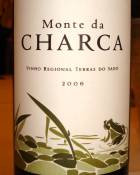
More labels from Quinta de Catralvos
Monte da Charca White, Terras
do Sado, 2007 –
Monte means estate in Alentejo (wheras most of Portugal its Quinta). This white
is a blend of Arinto and Moscatel and its fresh and floral with loads of citrus
and honeysuckle with a slice of stone fruits and a drop of rose oil. Zippy fresh
on the palate with flavours that echo the aromas – very tasty.
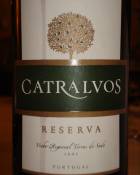
The Catralvos Reserva Red,
Terras do Sado, 2005
opens with dark brooding fruit, balsamico and dark
earth then opens up to raspberries and blueberries lifted with mint. The palate
is ripe berry and pepper – it has loads of big, juicy flavours, a smooth texture
and good structure. Very nice.
The Catralvos Moscatel
Setúbal, 2003 is a gorgeous Moscatel fortified with Armagnac Brandy. It has
25% Armagnac and 75% Moscatel juice – the alcoholic fermentation is stopped
after 1-2 days by addition of the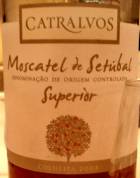 Armagnac which leaves the wine at a high sugar
level and about 17.5% alcohol at finish. This wine spent five years in barrel
(to be Setúbal it must have a minimum of two years in barrel) and it was
released in August of this year. The aromas are honey, tea leaves and caramel
apricots, its rich complex and sweet with good acidity and a lovely Armagnac
linger. Great with strong cheeses with marmelada (quince paste) or the local
sweet jelly rolled sponge cake desserts.
Armagnac which leaves the wine at a high sugar
level and about 17.5% alcohol at finish. This wine spent five years in barrel
(to be Setúbal it must have a minimum of two years in barrel) and it was
released in August of this year. The aromas are honey, tea leaves and caramel
apricots, its rich complex and sweet with good acidity and a lovely Armagnac
linger. Great with strong cheeses with marmelada (quince paste) or the local
sweet jelly rolled sponge cake desserts.
I would also pair it with apricot
crumble, crème caramel or crème brulee.
For more information on Quinta de Catralvos
click here
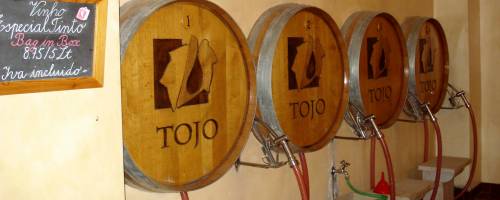
Buying wine in bulk at Catralvos. I wish...
Alentejo
(Alentejano)
– Southern Region
Santa Vitoria vineyard below
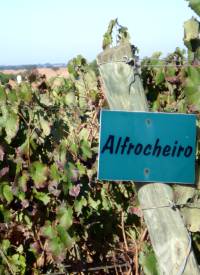 Alentejo was my
greatest surprise and my biggest crush of this trip. The wide open spaces,
gently rolling landscape, the arid, savannah-like geography. The oak cork trees
dotting the roadside constantly drew my attention, as the sun warmed me during
that end of
October excursion. The sunsets in Alentejo are stunning – ranging from burnt orange to
brilliant fuchsia while the wines are bold and sometimes as untamed as the Alentejo terrain. This is a region that is seeing resurgence. Youth, enthusiasm
and modernism is returning to this modest land. Once young people left the small
villages here to find work in Lisbon. Now they return to create a new life for
themselves, responding to the unaffordable big-city dream and constant busyness. It’s a hot region,
Alentejo was my
greatest surprise and my biggest crush of this trip. The wide open spaces,
gently rolling landscape, the arid, savannah-like geography. The oak cork trees
dotting the roadside constantly drew my attention, as the sun warmed me during
that end of
October excursion. The sunsets in Alentejo are stunning – ranging from burnt orange to
brilliant fuchsia while the wines are bold and sometimes as untamed as the Alentejo terrain. This is a region that is seeing resurgence. Youth, enthusiasm
and modernism is returning to this modest land. Once young people left the small
villages here to find work in Lisbon. Now they return to create a new life for
themselves, responding to the unaffordable big-city dream and constant busyness. It’s a hot region,
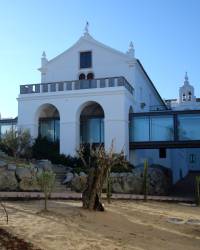 with
little rainfall and summer temperatures that soar to 40 degrees - hotter than
ever before.
with
little rainfall and summer temperatures that soar to 40 degrees - hotter than
ever before.
Proof is in the 2008
vintage which began harvesting on August 15th – 30 days earlier than 15
years ago.
In Alentejo the
stunning white grape Antão Vaz is stealing the show and Alicante Bouschet holds
great promise side-by-side with Trincadeira, Aragones and Castelão.
Convento do Espinheiro in Evora (right) has been
transformed into a 5 star, modern, luxury hotel
Here porco preto seems
to be everywhere. Known around the country and around the world by chefs and
foodies this black pig (perhaps a cousin to the
 wild boar) shows up in many
forms on the table. Dog fish soup sopa de cação was also served and with
the obligatory finale ‘sweet’ desserts – candied plums in sweet syrup. It was
also in Alentejo where I sampled the best olive oils
wild boar) shows up in many
forms on the table. Dog fish soup sopa de cação was also served and with
the obligatory finale ‘sweet’ desserts – candied plums in sweet syrup. It was
also in Alentejo where I sampled the best olive oils
I have ever tasted.
There is always a bottle of the house olive oil (or several) on each table and a
small dish to dip your bread and local cheese.
Oh, I forgot to mention the bread in Portugal…words cannot describe.
Cartuxa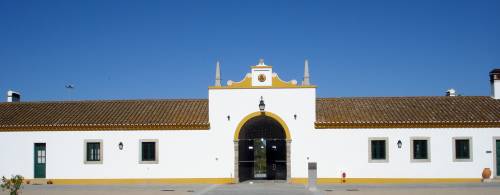
Near the gorgeous town of Évora,
Cartuxa is a large state-of-the-art computerized winery built for 10 million
euros on the Quinta de Valbom in 2006. Cartuxa has left the facade of its
history as a former Jesuit house which became a national treasure in 1755.
Cartuxa came about due to a foundation -
Fundação Éugenio de Alemeida
- set up by
philanthropist Vasco Maria Éugenio de Alemeida a wealthy landowner who
died in 1975 and had no children. His charitable foundation was set up in 1963
to aid in local church upkeep, for community support and for schools and the
University of Évora. The foundation also has cattle, cork forests, olive trees
and olive oil production as well as 6500 hectares of land of which the Cartuxa
vineyards, DOC of Alentejo~Évora, are part of.
The Cartuxa wines fall under four labels starting with the regional entry label
EA moving upward to the DOC labels of Foral De Évora, Cartuxa and Pêra-Manca.
In total, three
million bottles are produced each year.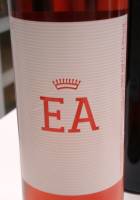
EA White, Alentejo, 2007
is both fresh and creamy with bright citrus, floral and tree fruit aromas. It is
easy drinking with an almost oily texture lovely creamy, ripe fruit and spice
flavours as well as rounded acidity on the palate.
EA Rosé Castelão, Alentejo,
2007 is a pretty
rosé coloured wine made from Grenache and Syrah and has aromas of summer berries
– particularly strawberry, lovely floral notes from the Grenache. Its very
bright with just a hint of sweetness and flavoured with red berries and citrus
peel.
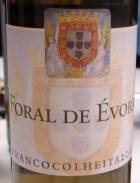 EA Selection Red, Alentejo,
2007 is a blend of
Trincadeira, Arogones (aka Tinta Roriz or Tempranillo in Spain) and Castelão. It
has ripe, upfront fruit aromas – plums and black cherry with spice. The texture
is smooth and the wine shows surprising integration and age for one so young –
hints of dried fruits, cedar and fruitcake spices.
EA Selection Red, Alentejo,
2007 is a blend of
Trincadeira, Arogones (aka Tinta Roriz or Tempranillo in Spain) and Castelão. It
has ripe, upfront fruit aromas – plums and black cherry with spice. The texture
is smooth and the wine shows surprising integration and age for one so young –
hints of dried fruits, cedar and fruitcake spices.
Foral de Évora Vinho Branco,
Évora~Alentejo DOC, 2007 is Assario (Malvasia), Roupeiro (aka Serial) and Arinto. It has earthy
and mineral aromas with honey, pear and melon. Weighty and creamy on the palate
with more complexity than the EA wines its smooth with honey,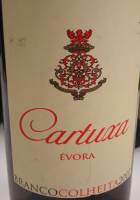 minerals, creamy
white fruits and citrus on the finish.
minerals, creamy
white fruits and citrus on the finish.
Foral de Évora Vinho Tinto
Évora~Alentejo DOC, 2005
blends Trincadeira, Alicante Bouschet and Arogonez for the delicious aromas of
dried cherries, sweet spices and cocoa. Its smooth and supple with good
intensity and linger and loads of spice on the palate as well as oak flavours
and drying tannins on the finish.
Cartuxa Vinho Branco
Évora~Alentejo DOC, 2007
blends Antão Vaz, Roupeiro and Arinto to make this ripe wine. Aromas of tropical
fruits, melon, minerals and honey, a creamy palate – fresh and rounded – citrus,
spice and
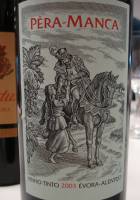
mineral flavours with a zesty finish.
Pêra-Manca Vinho Branco
Évora~Alentejo DOC, 2006
is a split between my two darlings - Arinto and Antão Vaz showing round buttery
aromas, pineapple and caramel, pears and melon. The palate is quite lush and
rounded with complex layers of spice and fruit, nuts and pears. The finish
lingers admirably.
Pêra-Manca Vinho Tinto
Évora~Alentejo DOC, 2005
blends Trincadeira and Arogones into this ultra-premium wine. Its savoury –
char-grilled meaty tones, bacon fat, fleur de sel and dark fruits. This wine
needs food and perhaps a few more years to soften and smooth out. The 2003 is
also big, dark and ripe – its fresh, laden with dark fruit, chocolate and spice
- complex and layered with nice acidity – drinking nicely now.
Cortes de Cima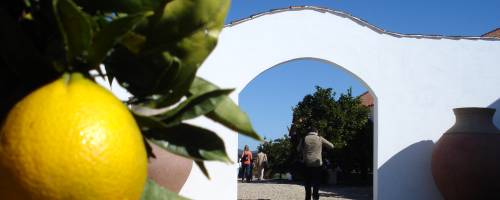
 I first tasted the wines from
the Cortes de Cima Family Vineyards, in spring 2008 at the Vancouver Playhouse
International Wine Festival. I was wowed by their ripe fruit and bright new
world styles – never knowing I would be fortunate enough to visit them in just
seven months. Cortes de Cima is owned by Carrie and Hans Kristian Jorgensen.
Carrie’s grandfather father moved to New York in the late 1800s from the Azores.
Hans was an engineer in Malaysia – growing cocoa, tea, coconut and palm oil when
he and Carrie met. Their choices were many but they settled in Alentejo, in
Vidigueira, where
they started from scratch and planted their vines. The total estate is about 365
hectares of which just over 100 are
Carrie and Hans Kristian Jorgensen
I first tasted the wines from
the Cortes de Cima Family Vineyards, in spring 2008 at the Vancouver Playhouse
International Wine Festival. I was wowed by their ripe fruit and bright new
world styles – never knowing I would be fortunate enough to visit them in just
seven months. Cortes de Cima is owned by Carrie and Hans Kristian Jorgensen.
Carrie’s grandfather father moved to New York in the late 1800s from the Azores.
Hans was an engineer in Malaysia – growing cocoa, tea, coconut and palm oil when
he and Carrie met. Their choices were many but they settled in Alentejo, in
Vidigueira, where
they started from scratch and planted their vines. The total estate is about 365
hectares of which just over 100 are
Carrie and Hans Kristian Jorgensen
with Coutinho (middle)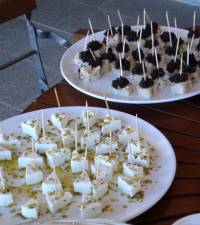
under vine. Cortes de Cima does what it can
(including illegal Smart Dyson trellis systems) to cut back on chemical use in
the vineyards. They also have south facing solar panels to assist in energy collection
and recycle their winery waste water. The wines have a distinct new world style
– fruit forward but still balanced and food friendly – a trend I noticed in Alentejo.
Cortes de Cima is a lovely, quaint
estate dotted with citrus trees and flowers. It has a special occasion
kitchen and dining area where they served delicious house-made olive tepanade and
local soft cheese as well as typically wonderful Portuguese breads.
soft local cheese drizzled with olive oil
and fresh olive tepanade on bread cubes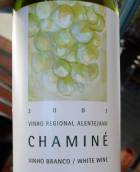
Cortes de Cima 'Chaminé' Vinho Branco, Alentejo 2007 is an aromatic and
satisfying white blend of
Antão Vaz, Arinto and Verdelho. It shows vibrant tropical fruit aromas, honey
and floral tones, juicy melon and pear on the nose and in the mouth - it's
creamy, yet bright on the palate with lovely fruit expression and zest flavours
on the finish. Delicious
Cortes de Cima 'Chaminé', Vinho Tinto, Alentejo, 2007 is a blend of
Aragonez (aka Tempranillo in Spain), Syrah,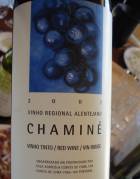 Touriga Nacional, Trincadera and
Cabernet. Think warm blueberry, sweet vanilla and coconut with undertones of
raspberry. Its juicy and ripe, with sweet fruit expressions, vanilla and cedarbox spices on the palate. Very easy-drinking.
Touriga Nacional, Trincadera and
Cabernet. Think warm blueberry, sweet vanilla and coconut with undertones of
raspberry. Its juicy and ripe, with sweet fruit expressions, vanilla and cedarbox spices on the palate. Very easy-drinking.
BC
private wine stores
Chaminé 2006
vintage sells for about $20
Cortes de Cima, Alentejo, 2005 combines Syrah, Aragonez, Touriga Nacional
and Cabernet to make this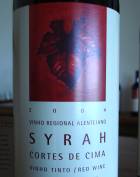 earthy juicy red with cherry/berry notes, smoky,
savoury tones and spices. It's medium-full bodied, smooth and fresh with a
polished finish.
earthy juicy red with cherry/berry notes, smoky,
savoury tones and spices. It's medium-full bodied, smooth and fresh with a
polished finish.
about $30+ BC private wine stores
Cortes de Cima Syrah, Alentejo, 2004
is a sweet ripe Syrah with raspberry and blueberry fruit and undertones of
saddle leather, savoury herbs and earth. Its smooth, full-bodied and fresh on
the palate with loads of juicy berries and chocolate. Yummy.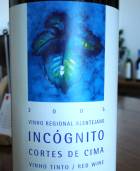
coming soon to BC
Cortes de Cima 'Incognito', Alentejo, 2005 is made from 100% Syrah, only
in the best vintages. It has savoury aromas of leather, forest floor, herbs and
a bit of lactic undertones. The fruit is dark and plummy, with violets and
floral notes. Creamy and ripe fruit on the palate, cedar box and peppery spice
flavours combine to make this wine smooth and elegant.
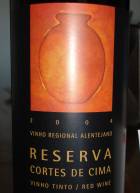
Cortes de Cima Reserva, Alentejo, 2004 blends Aragonez, Touriga Nacional,
Syrah and Cabernet Sauvignon in this premium wine. Ripe dark plums in chocolate,
coffee and sweet dark berry aromas. Powerful and intense with peppery fruit,
layered flavours and ripe tannins. Very good.
Herdade Do Esporão
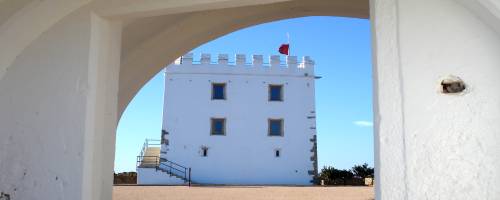
Looking at the
Esporão Tower built in the
1400s to watch for attacking Moors
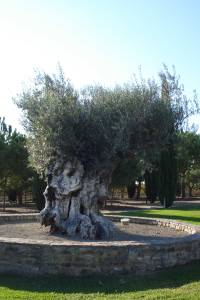 Herdade do Esporão is the
oldest estate in Portugal which has quite a colourful history. From the Esporão
tower built in the later 1400s to watch for attacking Moors to the recent
revolution (1975-1979) when the lands were seized and occupied.
Herdade do Esporão is the
oldest estate in Portugal which has quite a colourful history. From the Esporão
tower built in the later 1400s to watch for attacking Moors to the recent
revolution (1975-1979) when the lands were seized and occupied.
In 1980, the owners of Herdade Do Esporão – Finagra - were handed back the
seized lands but all
grape production had to be turned over to the local co-op. In 1987 that law was also
overturned and full control was in the hands of Finagra – within four months the
winery was built and today production is an astounding 15 million bottles per year under
chief Australian winemaker David Baverstock.
Esporão is a stunning property, its buildings are of traditional design to match the
whitewashed turreted
Esporão
tower down the road. It also has a large man-made lake for
use in vineyard irrigation as well as a wine shop and wine bar and a
restaurant.
a 400 year old olive tree that sits next to the
Esporão tower
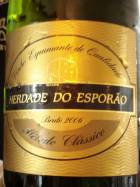 Herdade do Esporão Espumante, Alentejo is a blend of Verdelho and Antão
Vaz. It has rich aromas of honey and apple aromas and a fresh crisp palate with
a smooth mousse, creamy finish and its very, very tasty.
Herdade do Esporão Espumante, Alentejo is a blend of Verdelho and Antão
Vaz. It has rich aromas of honey and apple aromas and a fresh crisp palate with
a smooth mousse, creamy finish and its very, very tasty.
Esporão Reserva White, DOC Alentejo, 2007 is a white blend with primary Antão Vaz . It has
sweet and ripe aromas of tropical fruit, exotic flowers, vanilla and spice. The
tropical tones flow through to the palate with golden pineapple, minerals honey
and citrus flavours. Gorgeous.
The Herdade do Esporão‘Vinha da Defense’ Rosé,
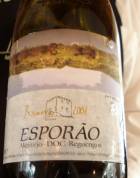 Alentejo, 2007 is a bright cranberry hue with sweet
aromas, candied strawberries, spiced citrus peel, cedar and pine. Crisp citrus
flavours with pomegranate and rhubarb hints. A blend of Syrah, Touriga Nacional
and Arogones.
Alentejo, 2007 is a bright cranberry hue with sweet
aromas, candied strawberries, spiced citrus peel, cedar and pine. Crisp citrus
flavours with pomegranate and rhubarb hints. A blend of Syrah, Touriga Nacional
and Arogones.
Esporão Reserva Red DOC
Alentejo, 2005 is a
very tasty blend of Trincadeira, Arongones (aka Tinta Roriz, aka Tempranillo)
and Cabernet Sauvignon. It shows Ripe black cherry and sweet berry fruit,
vanillin oak, spice and a fine seam of chocolate running throughout. Good
acidity on the palate, its flavours are cherries, chocolate and tobacco and fine
tannins linger on the finish.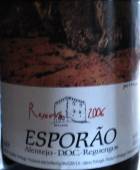
The 2006 of this wine also has some Alicante Bouschet and it’s a powerful wine –
lush and ripe – with jammy aromas of blackberry, coffee and chocolate. Luscious
on the palate with rich dark berry fruit an opulent texture, juicy freshness,
chocolate and vanilla flavours and powerful but ripe tannins. Delicious.
Herdade do Esporão ‘Monte Velho’
White, 2007 is a
blend of Roupeiro, Antão Vaz and Perrum showing a very fruity character or
tropical aromas, honey and floral with exotic citrus. It has a lovely weight on
the palate with soft round acidity and loads of citric flavours and hints of
spice.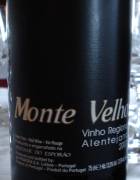
Herdade do Esporão ‘Monte Velho’,
Alentejo, 2007 – The
Monte Velho wines are the largest brand selling on the domestic market.
Light,fruity aromas, cherry and spiced red berries it’s earthy and sweet with
hints of leather and spiced tobacco – very easy drinking. A blend of Trincadeira,
Aragones and Castelão.
Herdade do Esporão Touriga
Nacional, Alentejo 2005
has fragrant floral and deep berry tones. It’s velvety and fleshy on the palate
with more floral hints and spiced mocha. Very good.
Herdade dos Grous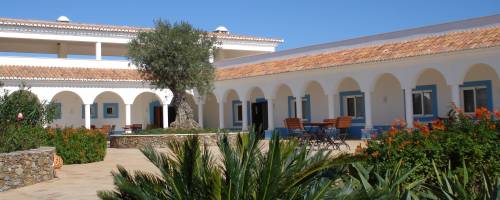
Herdade dos Grous' tag line is "Between Heaven and Earth" and who am I to argue.
I visited this Baixo estate on the last day of my trip. In fact it was the
last winery in Portugal I visited. It was a hot, dry Alentejo day and
Herdade dos Grous rose like an oasis from the arid terrain, painted pristine
white with Mediterranean blue trim it was as cool and crisp looking as its
manmade lake. This estate has 70 hectares of vines of which 90% are red. They
have been experimenting with non-traditional Portuguese grape varieties like;
Nebbiolo, Sangiovese, Semillon and Vermentino as well as traditional varieties.
Its a partially open winery, fermentation tanks reside beneath a roof, with
surrounding walls open to allow for Alentejo winds to naturally cool the tanks.
Like most Portuguese wineries, stainless steel Legares (low, foot trodding
tanks) are used in
a modern, mechanical way but in Herdade dos Grous
they are round rather than the usual rectangular shape I saw. The vineyards were
planted in 2002, the first vintage was (stunningly) in 2004 and the final winery
was built in 2005. Grous believes in Moon Harvesting, a somewhat confusing
science which tells them the perfect time to pick their grapes for optimum
flavour and ripeness. Less perplexing though is enotourism, which is alive and
thriving at Herdade dos Grous as well. Across the lake is their country house with 24 rooms.
There is a restaurant at the winery or at the inn as well as a swimming pool and
like nearby winery
Casa Santa Vitória you can sign up with Emotion Outdoor Activities to
ride horses, go up in a hot air balloon or drive the vineyards on motorized
quads.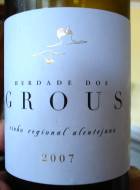
Herdade dos Grous White Wine, Alentejano, 2007 blends Antão Vaz, Arinto
and Roupeiro into this clean, tropical and citrus-y wine. It has an
almost oily texture with great fruit expression and clean fruit/citric flavours.
Great paired with sheep's milk cheese and toast with olive oil and tepanade.
Herdade dos Grous Reserva White Wine, Alentejano, 2006 is an oak fermented
and aged blend of Antão Vaz, Verdelho and Viognier and shows rich vanilla oak
aromas, butter and tropical fruit - pineapple and some creamy pear
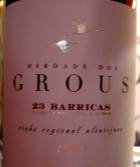 notes. The
creamy, buttery flavours and oak spice run throughout the palate making this a
good pairing with creamy pumpkin risotto.
notes. The
creamy, buttery flavours and oak spice run throughout the palate making this a
good pairing with creamy pumpkin risotto.
Herdade dos Grous, Red Wine,
Alentejano, 2007 (barrel sample - to be bottled December 2008) blends
Alicante Bouschet, Syrah, Touriga Nacional and Tinta Miuda (aka Graciano). It
showed intense dark fruits, rosemary and mixed savoury herbs and spice. The
palate is youthful, tannins are ripe and the flavours are dense and dark with
savoury tones, fleur de sel and spice. I look forward to trying this wine again
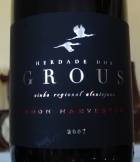 in a few years.
in a few years.
Herdade dos Grous '23
Barricas', Alentejano, 2006 blends Touriga Nacional and Syrah to make this
flagship red. It spent 12 months in French oak barrels and has loads of juicy
blueberry, chocolate and fruitcake spices. The palate is Elegant and direct with
layers of powerful flavours - mixed berries, smoke, tobacco and spice with
lovely, balanced acidity.
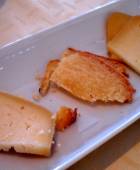 Herdade dos Grous
'Moon Harvest, Alentejano, 2007 is made from 100% Alicante Bouschet. Its a
young brooding wine with earthy, charred aromas and reserved red fruit. The red
fruit reappears on the palate with spice and cedar. Its fleshy but not jammy,
youthful and a bit awkward right now but I look forward to tasting it again in a
few years like the 2007 Red.
Herdade dos Grous
'Moon Harvest, Alentejano, 2007 is made from 100% Alicante Bouschet. Its a
young brooding wine with earthy, charred aromas and reserved red fruit. The red
fruit reappears on the palate with spice and cedar. Its fleshy but not jammy,
youthful and a bit awkward right now but I look forward to tasting it again in a
few years like the 2007 Red.
wines from Alentejo pair well with the local sheep's milk cheese
For more information on Herdade Dos Grous
click here

Looking across the man made lake toward their country inn
from Herdade dos Grous
Herdade da Malhadinha Nova
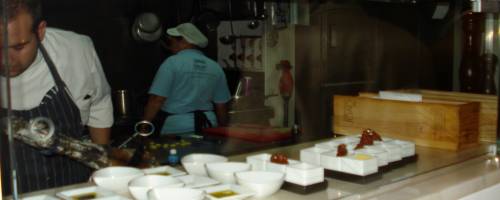
The kitchen at restaurant de Malhadinha

Herdade da Malhadinha was built in 1998 by two brothers and their partners.
The Soares family own a group of
14 wine shops and distribution company in the Algarve region so
their love of wine comes naturally. In 1998 they purchased this 200 hectare
estate just south of Beja. It was a far less modern estate with run down bards
and buildings that they completely renovated. Now they have an inn, a gorgeous
modern restaurant called Restaurante da Malhadinha, a wine store and winery.
Rita Soares
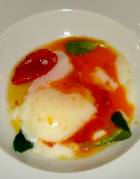 Their estate is also home to cork oak
trees, cattle and the favoured flavourful regional specialty - black pig -
porco preto.
Their estate is also home to cork oak
trees, cattle and the favoured flavourful regional specialty - black pig -
porco preto.
The labels are adorable and memorable crayon drawings by the children of João
and Rita Soares. The production is limited to the size of their small winery so
the focus continues to be on quality over quantity. An agent has contacted Malhadinha and the wines will be brought
into the British Columbia market soon.
Traditional tomato and egg 'soup' modernized at Malhadinha
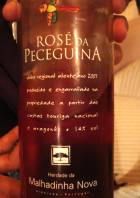 Herdade da Malhadina Rosé da Peceguina, Alentejano, 2007 is as fresh and
juicy as it looks - the pink label is clean and fun and the wine is dry with
juicy red berries and a hint of spice. Great as an aperitif or with starters,
fish or duck.
Herdade da Malhadina Rosé da Peceguina, Alentejano, 2007 is as fresh and
juicy as it looks - the pink label is clean and fun and the wine is dry with
juicy red berries and a hint of spice. Great as an aperitif or with starters,
fish or duck.
Herdade da Malhadina Monte da Peceguina, Alentejano, 2007 -
Antão Vaz with Verdelho
and Arinto in this fresh, clean wine with bright, floral, honey and tropical
aromas. The fruit on the palate is vibrant and tropical, the texture is quite
creamy the acid soft and round. Very good.
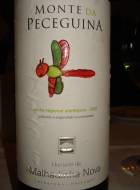 'Malhadina' Vinho Branco, Albernôa, 2007 blends the Alenrtejano white queen
Antão Vaz with Verdelho
and Chardonnay. This wine is buttery and spice with toasty notes and
tropical fruit aromas. Rounded and creamy on the palate with earthy, musky honey
notes and loads of spice. Good paired with smoked cheeses or the local Serpa
sheep's milk cheese with its earthy, smoky nuances.
'Malhadina' Vinho Branco, Albernôa, 2007 blends the Alenrtejano white queen
Antão Vaz with Verdelho
and Chardonnay. This wine is buttery and spice with toasty notes and
tropical fruit aromas. Rounded and creamy on the palate with earthy, musky honey
notes and loads of spice. Good paired with smoked cheeses or the local Serpa
sheep's milk cheese with its earthy, smoky nuances.
'Malhadina' Vinho Tinto, Albernôa, 2006 is a blend of Syrah, Touriga
Nacional, Cabernet Sauvignon and Alicante Bouschet. We tasted this wine from a
Magnum and it was filled with juicy red berry, blueberry, coffee chocolate, and
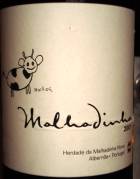 cedar flavours with intriguing minerality and solid structure on the palate. The
'Malhadina' Vinho Tinto, Albernôa, 2003 vintage had similar
blueberry tones, with cherry, forest floor and woodsy aromas. The palate shows
youthful fresh fruit, a hint of bacon fat but lovely structure and bright
acidity with spice and integrated tannins on the finish.
cedar flavours with intriguing minerality and solid structure on the palate. The
'Malhadina' Vinho Tinto, Albernôa, 2003 vintage had similar
blueberry tones, with cherry, forest floor and woodsy aromas. The palate shows
youthful fresh fruit, a hint of bacon fat but lovely structure and bright
acidity with spice and integrated tannins on the finish.
Marias da Malhadinha, Alentejano, 2004 is an ultra premium wine made from
the best grapes of the vintage and blends Aragones, Touriga Nacional and
Cabernet. Its earthy
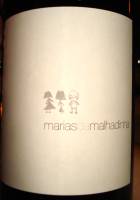 and brooding with leather, bacon fat and some fleur de sel
followed by cassis and chocolate, coffee and spice. It spent 26 months in new
French oak which gives it even more backbone but the acidity and freshness
remains.
and brooding with leather, bacon fat and some fleur de sel
followed by cassis and chocolate, coffee and spice. It spent 26 months in new
French oak which gives it even more backbone but the acidity and freshness
remains.
For more information on Herdade da Malhadinha
click here
Herdade do
Rocim

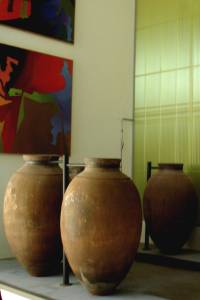 "Life is good but wine is better" is
quoted on one outstanding wall in the
architecturally striking winery of Herdade do Rocim. Located between the towns of Vidigueira and Cuba (where it is
believed Christopher Columbus was born) this elemental winery features features
water, wood, stone and metal combined in simple lines with stunning splashes of
colour. Rocim has a casual/contemporary wine bar that looks out onto an open
courtyard with a small theatre area and a waterfall. Above the winery an open
terrace looks out over the 60 some hectares of vineyards. The winemaker, a
diminutive tinkerbell sized lass places pretty stickers and ribbons on the tanks
she considers her "babies" the ones who are her favourite and must be treated
with care.
"Life is good but wine is better" is
quoted on one outstanding wall in the
architecturally striking winery of Herdade do Rocim. Located between the towns of Vidigueira and Cuba (where it is
believed Christopher Columbus was born) this elemental winery features features
water, wood, stone and metal combined in simple lines with stunning splashes of
colour. Rocim has a casual/contemporary wine bar that looks out onto an open
courtyard with a small theatre area and a waterfall. Above the winery an open
terrace looks out over the 60 some hectares of vineyards. The winemaker, a
diminutive tinkerbell sized lass places pretty stickers and ribbons on the tanks
she considers her "babies" the ones who are her favourite and must be treated
with care.
It is here, at Herdade do Rocim, where I attended an Antão Vaz seminar in
conjunction with
ViniPax
(read more
here).
We tasted 11 different whites made from this lovely aromatic variety - from
clean, crisp stainless steel only aged to ripe, buttery oak aged versions.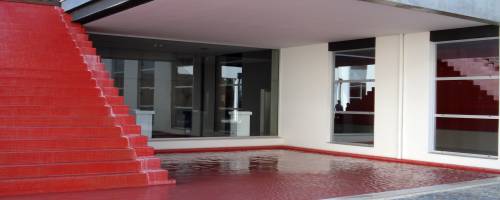
courtyard
at Rocim a stair waterfall and shallow pond outside the wine bar.
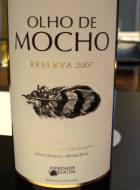 Herdade do Rocim
Olho de Mocho Branco Reserve,
Alentejo, 2007
is made from
Antão Vaz and has an
elegant, minerally nose. Peaches aromas - its fruity and floral with some honey/mushroomy
undertones. The palate is has flinty flavours with citrus, a slightly oily
texture and soft rounded acidity.
Herdade do Rocim
Olho de Mocho Branco Reserve,
Alentejo, 2007
is made from
Antão Vaz and has an
elegant, minerally nose. Peaches aromas - its fruity and floral with some honey/mushroomy
undertones. The palate is has flinty flavours with citrus, a slightly oily
texture and soft rounded acidity.
Herdade do Rocim Olho
de Mocho, Tinto Reserva, Alentejo, 2006 is a blend of Touriga Nacional and
Syrah. Its toasty and spiced with chocolate and fresh berries - the
acidity is
quite lifted, he tannins are ripe and linger in the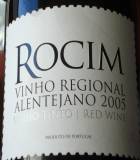 mouth.
mouth.
Herdade do Rocim 'Grand
Rocim', Alentejo, 2007 blends 90% Alicante Bouschet and the rest Touriga
Nacional in this ultra premium wine. This wine spends 11 months in new French
barrels and will spend 6 months in bottle before release. Its savoury and meaty
with ripe dark fruits, vanilla tones and sweet spices with undertones of bacon
fat. Smooth and intense showing sweet dark fruit on the palate with flavours of
blueberry, cedar, vanilla, cinnamon and
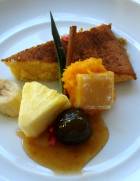 cloves. Its hot and spicy with good
acidity and ripe youthful tannins. Impressive.
cloves. Its hot and spicy with good
acidity and ripe youthful tannins. Impressive.
traditional egg based 'sweets' fluffy cakes with candied
plum and fruit
For more information on Herdade do Rocim
click here
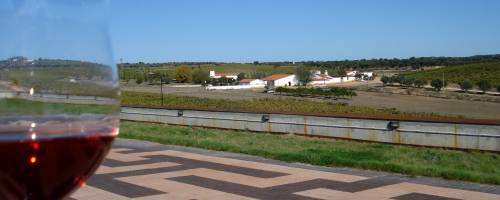
a glass of rose and looking out over the vineyards at
Herdade do Rocim
Casa de Santa Vitória
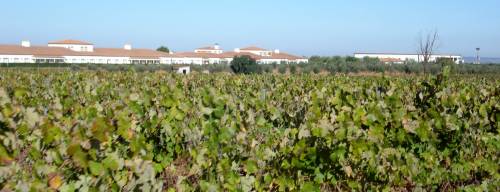
The vineyards and winery of Santa Vitoria alongside the
Hotel Vila Gale Clube - enotourism
 Casa de Santa Vitória is owned by
a Potuguese hotel chain called Vila Gale (I stayed
at one of their hotels - Vila
Gale Opera while in Lisbon) and the winery resides on the property of Vila Gale Clube de Campo about 25 km from the town of Beja. Here, in Alentejo there is a
fresh feel to this resort where outdoor activities and “Enotourism” are the
focus. Besides tasting the wines of Santa Vitória you sign up with Emotion
Outdoor Activities to ride horses or go
ballooning, take 4-wheel all terrain vehicle tours, golf, clay pigeon shooting
or play water sports, there is also a bullring as well as a lovely spa - and
there are lots of good looking young men - ladies.
Casa de Santa Vitória is owned by
a Potuguese hotel chain called Vila Gale (I stayed
at one of their hotels - Vila
Gale Opera while in Lisbon) and the winery resides on the property of Vila Gale Clube de Campo about 25 km from the town of Beja. Here, in Alentejo there is a
fresh feel to this resort where outdoor activities and “Enotourism” are the
focus. Besides tasting the wines of Santa Vitória you sign up with Emotion
Outdoor Activities to ride horses or go
ballooning, take 4-wheel all terrain vehicle tours, golf, clay pigeon shooting
or play water sports, there is also a bullring as well as a lovely spa - and
there are lots of good looking young men - ladies.
They have a total of 1600 hectares of land on which 100 hectares (plus 30 more
recently) is planted vines and nearly 100 hectares of planted olive trees
(delicious olive oil), animals and grains as well as the largest artificial lake
in Europe. Of the 70,000 bottles of wine Santa Vitória
winemaker Bernardo Cabral
produces each year 30%
are white and increasing
according to winemaker Bernardo Cabral.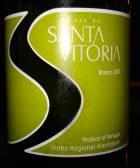
Santa
Vitória Vinho Branco,
Alentejo, 2007 is a blend of Arinto, Antão Vaz, Roupiero and Chardonnay. It
is fresh and crisp with citrus and tropical fruit and hints of floral and spice.
A nice aperitif wine or with starters.
Santa
Vitória Touriga Nacional,
Alentejo, 2006 is rich and smooth with sweet berry and chocolate. Its jammy
and juicy, a new world style with spiced vanilla tones. As its so fleshy and
ripe on the palate it makes this wine very easy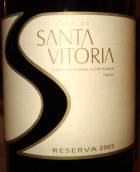 drinking.
drinking.
Santa
Vitória Reserva, Alentejo,
2005 blends Touriga Nacional, Cabernet and Syrah to make a wine with juicy
dark berry and plummy fruit, tobacco, coffee and mixed spice. It has ripe,
liqueur-like intensity, it's supple and smooth with polished tannins.
Santa
Vitória 'Inevitável',
Alentejo, 2004 is a blend of 50/50 Touriga Nacional and Merlot in this ultra
premium wine.
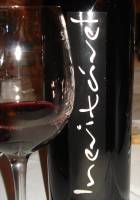 Its rich dark and brooding with black cherry and plums, savoury
tones and bittersweet chocolate. Its powerful on the palate with earthy,
tobacco, cocoa and spice with fine tannins throughout. The finish continues
on...
Its rich dark and brooding with black cherry and plums, savoury
tones and bittersweet chocolate. Its powerful on the palate with earthy,
tobacco, cocoa and spice with fine tannins throughout. The finish continues
on...
For more information on Casa Santa Vitória
click here
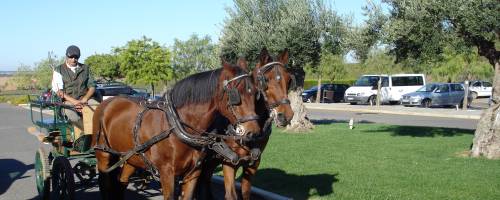
A lovely way to visit the vineyards of Santa
Vitória in carriage with Emotion
Outdoor Activities
Vinipax 2008
- Wine and Sensations from the south of Portugal.
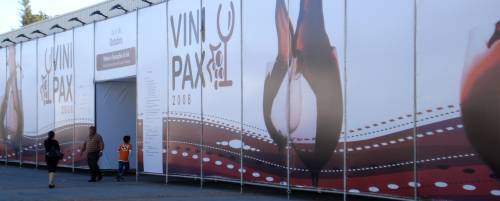

Anibal Coutinho (right)
the Technical Director of ViniPax, is a friend, wine journalist, author,
enologist and an integral part of ViniPax. Coutinho is nurturing ViniPax it into
a larger wine event each year.
The name ViniPax is a blend of Vini (wine) and Pax Giulia which is the historic
Roman name of Beja. Although still in its infant stages (next year will be its
third) ViniPax could some day prove to be one of the most important wine events
of the Iberian Peninsula, especially with a new airport in Beja due to be
completed spring 2009.
After my tour of Portugal in October I joined a group of international
journalists at ViniPax in Beja on the 24th-26th, where we tasted an broad range
of wines from around the south of Portugal.
Our group of 12 journalists, members
of F.I.J.E.V Anibal Coutinho
(International Federation of Wine and Spirits Journalist and
Writers),
judged the top wines of
ViniPax and
selected two winners - a white and a red.
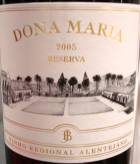
The white (vinho branco)
was from Ribatejano, Quinta da Alorna, 2007 a blend of Fernão Pires and
Arinto. This was a fresh bright white, with crisp citrus aromas. The palate
creamy with tropical notes - melon and stone fruits - and just a hint of
sweetness from the fruit.
The red (vinho tinto) was from Alentejano, Dona Maria Reserva, 2005, a
brawny blend of Alicante Bouschet, Petit Verdot and Syrah. Powerful and ripe
featuring creamy berry fruit, menthol, spice, dark floral notes, tobbacco and
cedar box. This is a wine that will taste more delicious after several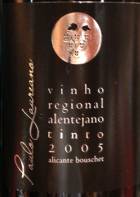 more
years.
more
years.
But, wandering around the room at ViniPax 2008 I found a couple of my own
favoriteslike the Paulo Laureano Vinho Regional Alentejano Alicante Bouschet,
2005 from the sub-region of Vidigueira. A commanding wine with intense black
cherry and berry, dark floral, chocolate, spice and powerful but ripe lingering
tannins.
The Henrique Uva Alfaraz Reserva, 2007
Antão Vaz is everything I love
about the gorgeous, warm-climate-loving, white Antão Vaz grape. Ripe tropical
fruit notes, exotic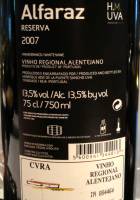 flowers and spice.Lovely weight on the tongue, creamy
texture yet crisp, citrus-y and spiced with mouth-watering
acidity. Vibrant!
flowers and spice.Lovely weight on the tongue, creamy
texture yet crisp, citrus-y and spiced with mouth-watering
acidity. Vibrant!
And the Herdade das Servas Vinhas Velhas, 2005 made from Alicante
Bouschet and Touriga Nacional is a powerful display of what Alicante Bouschet
can do in this region - ripe berry fruit, powerful and structured with firm
young tannins this wine is worth a revisit in a couple more years.
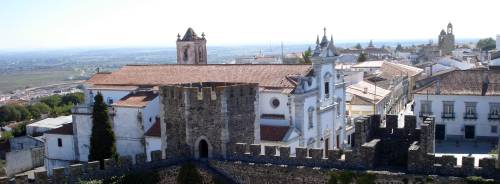
Looking out over the quaint hilltop town of Beja
Link to Part 1
of "Portugal is knocking -
Beiras, Estremadura & Ribatejo"







 words amo-te (in love) seemed sweet but kind of
promotional. But I understand its appeals, especially to female consumers and of
course it’s perfect for weddings and Valentine’s Day. The wine inside isn’t
sweet and submissive by any means – it shows smoky dark berry and plummy aromas
with chocolate covered blueberries and espresso. It’s full bodied and spicy on
the palate smoothly textured with a dry finish. A blend of Cabernet Sauvignon,
Arogones, Syrah and Touriga Nacional.
words amo-te (in love) seemed sweet but kind of
promotional. But I understand its appeals, especially to female consumers and of
course it’s perfect for weddings and Valentine’s Day. The wine inside isn’t
sweet and submissive by any means – it shows smoky dark berry and plummy aromas
with chocolate covered blueberries and espresso. It’s full bodied and spicy on
the palate smoothly textured with a dry finish. A blend of Cabernet Sauvignon,
Arogones, Syrah and Touriga Nacional.





 wild boar) shows up in many
forms on the table. Dog fish soup sopa de cação was also served and with
the obligatory finale ‘sweet’ desserts – candied plums in sweet syrup. It was
also in Alentejo where I sampled the best olive oils
wild boar) shows up in many
forms on the table. Dog fish soup sopa de cação was also served and with
the obligatory finale ‘sweet’ desserts – candied plums in sweet syrup. It was
also in Alentejo where I sampled the best olive oils 








 Touriga Nacional, Trincadera and
Cabernet. Think warm blueberry, sweet vanilla and coconut with undertones of
raspberry. Its juicy and ripe, with sweet fruit expressions, vanilla and cedarbox spices on the palate. Very easy-drinking.
Touriga Nacional, Trincadera and
Cabernet. Think warm blueberry, sweet vanilla and coconut with undertones of
raspberry. Its juicy and ripe, with sweet fruit expressions, vanilla and cedarbox spices on the palate. Very easy-drinking.



 Herdade do Esporão is the
oldest estate in Portugal which has quite a colourful history. From the Esporão
tower built in the later 1400s to watch for attacking Moors to the recent
revolution (1975-1979) when the lands were seized and occupied.
Herdade do Esporão is the
oldest estate in Portugal which has quite a colourful history. From the Esporão
tower built in the later 1400s to watch for attacking Moors to the recent
revolution (1975-1979) when the lands were seized and occupied. 
 Alentejo, 2007 is a bright cranberry hue with sweet
aromas, candied strawberries, spiced citrus peel, cedar and pine. Crisp citrus
flavours with pomegranate and rhubarb hints. A blend of Syrah, Touriga Nacional
and Arogones.
Alentejo, 2007 is a bright cranberry hue with sweet
aromas, candied strawberries, spiced citrus peel, cedar and pine. Crisp citrus
flavours with pomegranate and rhubarb hints. A blend of Syrah, Touriga Nacional
and Arogones.



 notes. The
creamy, buttery flavours and oak spice run throughout the palate making this a
good pairing with creamy pumpkin risotto.
notes. The
creamy, buttery flavours and oak spice run throughout the palate making this a
good pairing with creamy pumpkin risotto. in a few years.
in a few years. Herdade dos Grous
'Moon Harvest, Alentejano, 2007 is made from 100% Alicante Bouschet. Its a
young brooding wine with earthy, charred aromas and reserved red fruit. The red
fruit reappears on the palate with spice and cedar. Its fleshy but not jammy,
youthful and a bit awkward right now but I look forward to tasting it again in a
few years like the 2007 Red.
Herdade dos Grous
'Moon Harvest, Alentejano, 2007 is made from 100% Alicante Bouschet. Its a
young brooding wine with earthy, charred aromas and reserved red fruit. The red
fruit reappears on the palate with spice and cedar. Its fleshy but not jammy,
youthful and a bit awkward right now but I look forward to tasting it again in a
few years like the 2007 Red.


 Their estate is also home to cork oak
trees, cattle and the favoured flavourful regional specialty - black pig -
porco preto.
Their estate is also home to cork oak
trees, cattle and the favoured flavourful regional specialty - black pig -
porco preto. Herdade da Malhadina Rosé da Peceguina, Alentejano, 2007 is as fresh and
juicy as it looks - the pink label is clean and fun and the wine is dry with
juicy red berries and a hint of spice. Great as an aperitif or with starters,
fish or duck.
Herdade da Malhadina Rosé da Peceguina, Alentejano, 2007 is as fresh and
juicy as it looks - the pink label is clean and fun and the wine is dry with
juicy red berries and a hint of spice. Great as an aperitif or with starters,
fish or duck. 'Malhadina' Vinho Branco, Albernôa, 2007 blends the Alenrtejano white queen
'Malhadina' Vinho Branco, Albernôa, 2007 blends the Alenrtejano white queen
 cedar flavours with intriguing minerality and solid structure on the palate. The
'Malhadina' Vinho Tinto, Albernôa, 2003 vintage had similar
blueberry tones, with cherry, forest floor and woodsy aromas. The palate shows
youthful fresh fruit, a hint of bacon fat but lovely structure and bright
acidity with spice and integrated tannins on the finish.
cedar flavours with intriguing minerality and solid structure on the palate. The
'Malhadina' Vinho Tinto, Albernôa, 2003 vintage had similar
blueberry tones, with cherry, forest floor and woodsy aromas. The palate shows
youthful fresh fruit, a hint of bacon fat but lovely structure and bright
acidity with spice and integrated tannins on the finish. and brooding with leather, bacon fat and some fleur de sel
followed by cassis and chocolate, coffee and spice. It spent 26 months in new
French oak which gives it even more backbone but the acidity and freshness
remains.
and brooding with leather, bacon fat and some fleur de sel
followed by cassis and chocolate, coffee and spice. It spent 26 months in new
French oak which gives it even more backbone but the acidity and freshness
remains.




 cloves. Its hot and spicy with good
acidity and ripe youthful tannins. Impressive.
cloves. Its hot and spicy with good
acidity and ripe youthful tannins. Impressive.




 Its rich dark and brooding with black cherry and plums, savoury
tones and bittersweet chocolate. Its powerful on the palate with earthy,
tobacco, cocoa and spice with fine tannins throughout. The finish continues
on...
Its rich dark and brooding with black cherry and plums, savoury
tones and bittersweet chocolate. Its powerful on the palate with earthy,
tobacco, cocoa and spice with fine tannins throughout. The finish continues
on...





